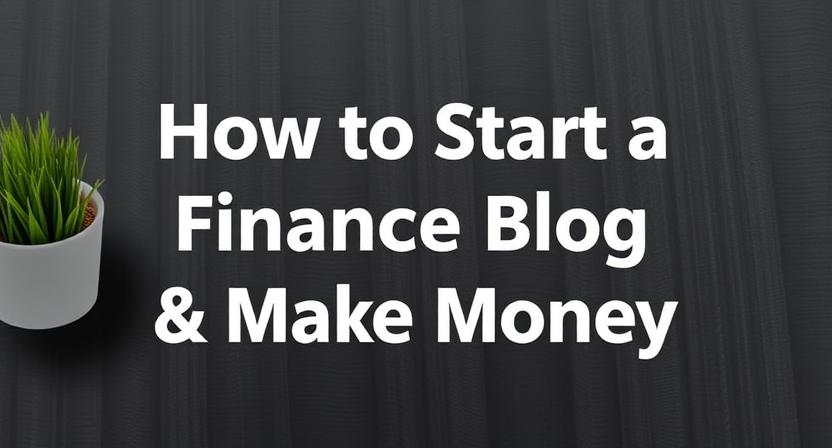Starting a finance blog can be a lucrative way to share your knowledge, build an audience, and generate income. Whether you’re passionate about personal finance, investing, budgeting, or the financial industry, a finance blog offers endless possibilities to educate others and turn your expertise into a profitable business.
In this comprehensive guide, we’ll walk you through the steps to start a finance blog and how to monetize it for maximum earnings.
1. Choose a Niche in the Finance Industry
The finance space is vast, and narrowing your focus will make it easier to attract a targeted audience. Consider these popular niches within the finance industry:
- Personal Finance: This includes budgeting, saving money, paying off debt, and managing personal finances.
- Investing: Cover topics like stock market investing, real estate investing, and cryptocurrencies.
- Financial Independence and Early Retirement (FIRE): Share tips on how people can achieve financial freedom and retire early.
- Credit Cards and Loans: Provide reviews, guides, and tips for using credit responsibly.
- Tax Planning: Offer insights into managing taxes, tax deductions, and tax saving tips.
- Business Finance: Help entrepreneurs manage their business finances, from budgeting to securing loans.
By selecting a specific niche, you can focus your content on the needs of a particular audience and differentiate yourself from the competition.
2. Choose a Domain Name and Hosting Provider
Your domain name is your blog’s online identity, and you want it to be easy to remember, relevant to your niche, and professional. For a finance blog, make sure the name reflects the theme of your blog and is easy to spell.
Once you’ve decided on a name, choose a reliable hosting provider to launch your blog. Some popular hosting providers for bloggers include:
- Bluehost: Known for great customer service and ease of use for beginners.
- SiteGround: Offers excellent performance and great support.
- HostGator: Affordable plans with a variety of hosting options.
Make sure the hosting provider supports WordPress, as it’s the most user-friendly platform for blogging.
3. Set Up Your Blog with WordPress
WordPress is the best platform for blogging due to its flexibility, ease of use, and abundance of plugins. To set up your blog:
- Install WordPress: Most hosting providers offer one-click installation for WordPress.
- Choose a Theme: Select a responsive and professional theme. There are many free and premium finance themes available on platforms like ThemeForest or WordPress’s theme library.
- Customize Your Site: Add essential pages such as “About Me,” “Contact,” and “Privacy Policy.” Personalizing your blog’s design and structure will ensure it looks professional and user-friendly.
- Install Plugins: Plugins will help you manage SEO, social media sharing, and performance. Popular plugins include:
- Yoast SEO for search engine optimization.
- WPForms for creating contact forms.
- Social Warfare for social sharing buttons.
4. Create High-Quality, Engaging Content
Content is the core of your finance blog. Your goal is to provide value to your audience through helpful, actionable, and accurate information. Here are some tips for creating quality content:
- Educate Your Audience: Write blog posts that address common finance problems or provide solutions to your readers’ needs. Whether it’s how to save money, make smart investments, or create a retirement plan, make sure the content is clear and easy to understand.
- Write Evergreen Content: Focus on topics that will remain relevant over time, such as “How to Budget for Beginners” or “Investing for Millennials.”
- Optimize for SEO: Use keyword research tools like Google Keyword Planner, Ahrefs, or Ubersuggest to identify high-volume search terms within the finance niche. Incorporate these keywords naturally into your blog posts to increase your chances of ranking higher on Google.
- Be Authentic and Transparent: Share personal stories or experiences, especially in the finance space where readers are looking for advice they can trust.
Content Ideas for Your Finance Blog:
- Guides on personal finance topics (e.g., “How to Save $10,000 in One Year”).
- Product reviews (e.g., credit cards, budgeting apps, and investment platforms).
- Step-by-step tutorials on financial planning.
- Interviews with financial experts or success stories.
5. Promote Your Blog and Grow Your Audience
Once you have some content published, the next step is to grow your audience. Without traffic, it will be hard to monetize your blog. Here are some strategies to increase visibility:
- Social Media: Use platforms like Instagram, Twitter, Facebook, and Pinterest to share your blog posts and engage with your audience. Visual content like infographics works well on Pinterest, while short tips are great for Twitter.
- Guest Posting: Write guest posts for other blogs in the finance niche. This will help you reach a broader audience and establish yourself as an authority in the field.
- Email Marketing: Build an email list by offering a freebie (like a financial checklist, eBook, or mini-course). Use email marketing platforms like Mailchimp or ConvertKit to nurture your list and keep readers engaged with your content.
- Networking: Connect with other bloggers and influencers in the finance space. Comment on their posts, collaborate on projects, and share each other’s content.
- SEO: Continue optimizing your content for SEO by focusing on long-tail keywords and backlinking strategies.
6. Monetize Your Finance Blog
Once you’ve built a steady stream of traffic, you can start monetizing your finance blog. Here are some of the best ways to make money:
1. Affiliate Marketing
Affiliate marketing is one of the most common and effective ways to make money from a finance blog. By promoting financial products (like credit cards, loans, investing apps, or personal finance tools) and including affiliate links in your posts, you earn a commission whenever someone clicks and makes a purchase.
Some popular affiliate programs for finance blogs include:
- Personal Capital
- Credit Card Affiliates (e.g., Chase, American Express)
- Wealthfront
- Betterment
2. Display Ads
Once your blog gets enough traffic, you can start placing display ads (like Google AdSense) on your blog. You’ll earn money based on impressions or clicks on the ads.
3. Sponsored Content
You can collaborate with companies in the finance industry that want to promote their products or services. In exchange for writing sponsored posts or creating content that promotes their offerings, you can charge a fee.
4. Sell Your Own Digital Products
Create and sell your own products, such as:
- E-books on personal finance or investing.
- Financial courses or workshops.
- Budgeting templates, spreadsheets, and planners.
5. Offer Financial Coaching or Consulting
If you have expertise in financial planning or investing, you can offer one-on-one coaching or consulting sessions. This is a high-ticket service that can be a great way to monetize your knowledge.
6. Create a Membership Site
Offer premium content to your readers for a monthly fee. This could include exclusive financial advice, access to webinars, or downloadable resources.
7. Track Your Progress and Scale Your Blog
Once your blog is monetized, track your progress using Google Analytics to understand your traffic and conversion rates. Over time, you can scale your blog by:
- Expanding your content to cover new sub-niches.
- Increasing your promotional efforts.
- Exploring new income streams like hosting webinars or launching paid products.
Conclusion
Starting a finance blog and making money from it is absolutely achievable, but it requires patience, consistency, and strategic planning. By focusing on a specific niche, creating valuable content, and implementing monetization strategies, you can build a successful finance blog that generates income while helping others improve their financial lives.






Leave a Reply